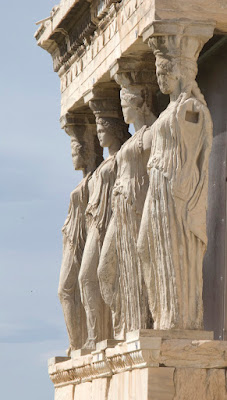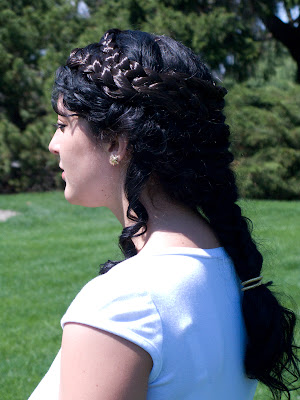Martha and Mary Magdalene, c. 1598, shows the saint at the moment of her conversion. It is from the Detroit Institute of Arts, but is currently on view in Caravaggio and His Followers, at the Kimbell Museum of Art
The inclusion of Martha with Mary Magdalen and other objects requires the viewer to interpret the symbolism. Martha is seated with her back to the viewer, with only one shoulder and her hands hit by Caravaggio's dramatic lighting. On the table are a comb, powder puff and mirror, symbols of vanity. Mary points to her chest holding a flower, while her other hand points emphatically to a diamond square of radiant light on the edge of the convex mirror.
The naturalistic light, seemingly projected from a window, is also a divine light, the ray of God which has inspired the worldly Mary Magdalen to "see the light." In the moment that Caravaggio highlighted and caught in paint, as if on camera, we witness spiritual transition. From this point on she will give up her luxury and prostitution to follow Jesus. By using models who resemble contemporary people in Rome, rather than Biblical characters, the viewers were supposed to identify with the personal nature of the conversion process.
Light is concentrated in a few important places: Martha's hands, Mary's face and chest, the hand and patch of light on the mirror. Sister Martha's hands are lit because she is pleading for Mary to change (and perhaps counting her sins and/or the reasons she should convert). Mary answers by pointing precisely to that light on the mirror.
Perhaps because Mary Magdalen was seen as an instrument of change, and as the most loyal companion of Jesus in his death, she was greatly idolized in the Middle Ages. The church of Sainte-Madeleine, Vezelay, in Burgundy, was a site of her relics and one of the most important of all pilgrimage churches. However, in the late 13th century, a 3rd century Christian tomb discovered in the crypt of a church in Provence was connected to Mary Magdalen. The site of her devotion then moved to this church and another site in the delta of the Rhone, where legend claimed she had relocated after Jesus' death.
After seeing Caravaggio's painting of Mary Magdalen, I thought differently of Georges de la Tour's The Penitent Magdalen at the National Gallery. Like Caravaggio, he used a contemporary young woman as his model. Yet this contemplative scene omits symbols of vanity and the light-dark contrast comes from candlelight hidden behind a skull. As Mary looks in the mirror, the skull is reflected rather than her face, as de la Tour has artfully manipulated perspective. Life as a sinner leads to a spiritual death. Death is inevitable, but if she chooses to follow Jesus she will die of the self and be reborn in new life.
Here Mary Magdalen may either be pondering her fate before conversion, or thinking of her wish to be reunited with Jesus in eternity later in life. Oddly, she caresses the skull as if wanting to die, perhaps because death for a person at peace with God is ultimate goal and preferable to life on earth. The shape of the skull mimics, in reverse, the shape of her sleeve, arm and hand, showing her intimate connection to thoughts of death. In his view, we are also encouraged to ponder our actions and/or sins and consider our life in eternity. Personal faith is in important factor of both the Reformation and Counter-Reformation at this time, although only the Catholic artists would portray
Georges de la Tour, The Repentant Magdalene, c. 1635, at the National Gallery of Art, Washington, shows her in a contemplative mode, perhaps thinking of death.
In the 6th century, Pope Gregory gave a sermon suggesting Mary Magdalen had been a prostitute before following Jesus. (Of her past, the Bible refers to the seven demons Jesus cast out of her, a vague description.) Although the church usually portrayed her to show that salvation is possible to all who ask for forgiveness, the model for Caravaggio's Mary Magdalen was Fillide Melandroni, one of Rome's most notorious courtesans. Neither she nor Caravaggio--who revolutionized art in his time--seem to have undergone a spiritual revolution. Caravaggio was frequently in fights and in 1606 he appears to have gotten into a fight with another man over Fillide, this remarkable woman.
(Note: Caravaggio's more famous paintings of religious calling/conversion are The Calling of St. Matthew and The Conversion of St. Paul, both in Rome and done around 1601. This artist's life is always a fascination to the public. There is a new biography about him by Andrew Graham-Dixon, Caravaggio: A Life Sacred and Profane, which may try to explain the contradictions of his life. A biography I read a long time ago is Desmond Seward, Caravaggio: A Passionate Life.)

























